A.I.R. Gallery — Mirroring the Art World Migration Pattern in New York City
YiWen Wang Sep 30, 2022 3 Minute Read
This essay is featured in the digital exhibition A.I.R. Gallery: Chapter 2.
When A.I.R. Gallery was established in 1972 in what used to be a machine store at 97 Wooster Street, in SoHo, the neighborhood was experiencing a revolutionary urban transformation from an industrial district to an artist enclave.
The city’s renewal plan for SoHo had collapsed in the early 1960s, leaving a host of vacant lofts with cheap rents suitable for artists, who could stay close to the then-major art scene in Greenwich Village. Despite their intermittent efforts to reshape the neighborhood, city officials unwittingly paved the way for SoHo’s artist-led urban development, which would end up saving the neighborhood from the urban crisis of the 1960s and ‘70s.

Digitized as part of a partnership between A.I.R. Gallery and The Feminist Institute, 2022. See record
In the early 1970s, considerable growth in the budgets of the National Endowment for the Arts (NEA) and New York State Council on the Arts (NYSCA) nourished the development of many nonprofit cooperative galleries in SoHo, including A.I.R. Gallery, the first cooperative gallery of women artists in the United States. To prepare the space for its use as a gallery, member artists had to build walls, refinish the floors, and wire the place. Howardena Pindell suggested the name Eyre Gallery for the space after Charlotte Bronte’s Jane Eyre, but the artists together decided on A.I.R. Gallery, referencing the artist-in-residence certificates required for artists to stay legally in SoHo’s loft buildings in the ‘60s and ‘70s. A.I.R. Gallery officially opened on September 16, 1972.
The requirement for artist-in-residence certificates did not stop non-artists from moving to SoHo. Eventually, rising demand for residential lofts and the passage of the Loft Law in 1981 kicked off the gentrification of the area. Deeply rooted in the SoHo art community and as a backlash to the Reagan administration, A.I.R. artists acutely grappled with the sense of crisis that shrouded the neighborhood in the ‘80s. In 1981, the group left their original home at Wooster Street and purchased a space at 63 Crosby Street, at the edge of SoHo. This new space allowed the gallery to expand its base to include works by women artists outside New York, a process formalized in the National Membership Program. However, the gallery’s failure to share its property ownership according to its cooperative’s rules sent it back to Wooster Street in 1994.
The late 1990s saw significant gentrification in SoHo. Many galleries and artists had to leave the neighborhood, and A.I.R. Gallery was no different. In 2002, A.I.R. moved to 525 W 25th Street in Chelsea, when the neighborhood was being rezoned much as SoHo had been years earlier. The gallery’s leadership may have foreseen what was coming after the first section of the nearby High Line opened to the public in 2009: A.I.R. left Manhattan for the first time in 2008, moving to 111 Front Street in DUMBO, Brooklyn.
Since the 1980s, DUMBO has slowly come to emulate SoHo in its urban-development cycles, despite the many artists who have relocated there since the late 1970s having demonstrated their wishes to protect their neighborhood from redevelopment. A naming committee made up of residents and artist-loft tenants even selected an intentionally silly name for their neighborhood in 1978, believing they would fool real estate agents and eventually save their community from being targeted. In time, DUMBO too was redeveloped. Later, the real estate firm Two Trees Management, which has supported the arts since the early years of DUMBO’s redevelopment in the 1990s, helped A.I.R. relocate to its current location at 155 Plymouth Street.
In 2022, A.I.R. Gallery continues to demonstrate its resilience and thrive even through a global pandemic. The work A.I.R. does is not possible without the continuous support of its community both within and outside of the gallery, including the artist members, gallery staff, DUMBO community, and the city of New York.
YiWen Wang is an art educator and arts administrator. From 2019 to 2020, she served as the interim assistant director at A.I.R. Gallery, Brooklyn, NY, and the family program facilitator at the Whitney Museum of American Art, New York, NY. She has organized programs at A.I.R. Gallery and BATURU Cultural Festival, Beijing, China, and she interned at the Whitney Museum of American Art; Museum of Chinese in America, New York, NY; Japan Society, New York, NY; Jewish Museum, New York, NY; and The Palace Museum, Beijing, China. Wang currently lives in Los Angeles, CA.